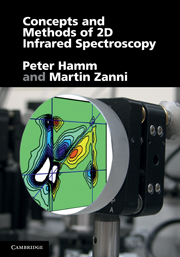Book contents
- Frontmatter
- Contents
- 1 Introduction
- 2 Designing multiple pulse experiments
- 3 Mukamelian or perturbative expansion of the density matrix
- 4 Basics of 2D IR spectroscopy
- 5 Polarization control
- 6 Molecular couplings
- 7 2D IR lineshapes
- 8 Dynamic cross-peaks
- 9 Experimental designs, data collection and processing
- 10 Simple simulation strategies
- 11 Pulse sequence design: Some examples
- Appendix A Fourier transformation
- Appendix B The ladder operator formalism
- Appendix C Units and physical constants
- Appendix D Legendre polynomials and spherical harmonics
- Appendix E Recommended reading
- References
- Index
Appendix C - Units and physical constants
Published online by Cambridge University Press: 05 August 2012
- Frontmatter
- Contents
- 1 Introduction
- 2 Designing multiple pulse experiments
- 3 Mukamelian or perturbative expansion of the density matrix
- 4 Basics of 2D IR spectroscopy
- 5 Polarization control
- 6 Molecular couplings
- 7 2D IR lineshapes
- 8 Dynamic cross-peaks
- 9 Experimental designs, data collection and processing
- 10 Simple simulation strategies
- 11 Pulse sequence design: Some examples
- Appendix A Fourier transformation
- Appendix B The ladder operator formalism
- Appendix C Units and physical constants
- Appendix D Legendre polynomials and spherical harmonics
- Appendix E Recommended reading
- References
- Index
Summary
In this appendix we list some of the commonly needed physical constants in spectroscopy. We also calculate the emitted field intensity directly from the third-order response functions for standard experimental conditions and molecular properties. The purpose of this calculation is not to obtain a highly accurate result, but to serve as a (somewhat interesting) exercise of units. In the following, we use units of meters-kilograms-seconds (SI units) unless otherwise noted.
- Type
- Chapter
- Information
- Concepts and Methods of 2D Infrared Spectroscopy , pp. 262 - 264Publisher: Cambridge University PressPrint publication year: 2011

